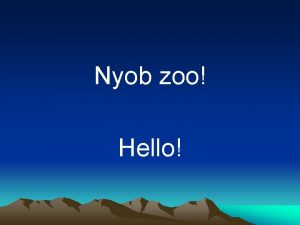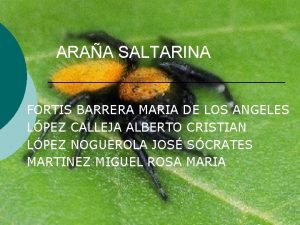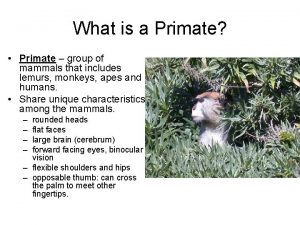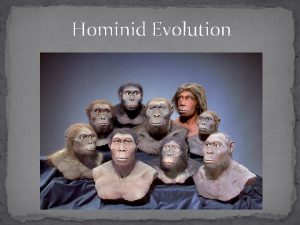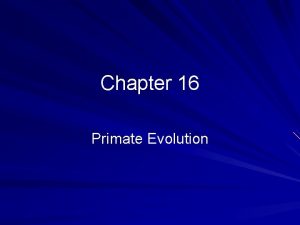Los Angeles Zoo Interdisciplinary Primate Research Project Ms
































































- Slides: 64

Los Angeles Zoo Interdisciplinary Primate Research Project Ms. E. Ohanian San Fernando High School Spring 2017

Table of Contents 1. Introduction: What are Primates? 2. Primate Taxonomic Classification 3. Primate Hands Family Tree 4. Prosimians 5. New World Monkeys 6. Old World Monkeys 7. Apes 8. Theory of Evolution: Charles Darwin 9. Field Research: Jane Goodall 10. Pictures of Primates at the Zoo

Introduction: What are Primates?

Introduction: What are Primates? According to Webster’s Dictionary, a primate is any of an order (Primates) of mammals that are characterized especially by advanced development of binocular vision resulting in stereoscopic depth perception, specialization of the hands and feet for grasping, and enlargement of the cerebral hemispheres and that include humans, apes, monkeys, and related forms.

Primate Taxonomic Classification

Primate Taxonomic Classification

Primate Hands Family Tree

Primate Hands Family Tree

Prosimians

Prosimians ● ● ● Lemur Loris Galago Tarsier Tree Shrew

Example of a Prosimian: Ring Tailed Lemur Common Name: Ring Tailed Lemur Genus + species: Lemur + L. catta Suborder: Strepsirrhini Infraorder: Lemuriformes Distribution/Range: The only place where members of the Superfamily Lemuroidea, including ring-tailed lemurs, can be found in the wild is Madagascar.

Example of a Prosimian: Ring Tailed Lemur Habitat: These mammals can be found living in the southwestern highlands of Madagascar. They usually inhabit forest areas with trees and plants that have shed their leaves or environments where few trees grow. Ring-tailed lemurs require forest habitats that have undisturbed by human activity. Social Organization: They live in small groups that move around with each other. These family groups have females that are dominate over the males. Conservation Status: Near Threatened by the International Union for Conservation of Nature (IUCN), due to habitat destruction by various causes such as man-made fires. Diet: They are known to prefer fruits, but also eat leaves, seeds, flowers, and various other parts of plants such as the bark and sap of trees. Lemurs are capable of raiding crops to eat watermelons and leaves of sweet potatoes.

Example of a Prosimian: Ring Tailed Lemur Fun Facts: ● Scientific name comes from the Latin word “lemures” meaning ghosts or spectators and catta, meaning cat. ● Carl Linnaeus, who is responsible for their Latin name, was inspired by Lemurs in Ancient Rome, which were specters or ghosts. ● A festival called the Lemuria were held to exorcise this spirits. ● The name lemur is from the Latin lemurs, meaning spirits of the dead. This name was selected for the lemur’s silent movement.

New World Monkeys (NWM)

New World Monkeys (NWM) ● ● ● Muriqui Uakari Capuchin Squirrel Monkey Howler Monkey Spider Monkey Golden Lion Tamarin Marmoset Callithnx Atelidae Mico

Example of a New World Monkey: Geoffroy’s Black-Handed Spider Common Name: Geoffroy’s Black-Handed Spider Genus + species: Ateles + A. paniscus Suborder: Haplorrhini Infraorder: Simiiformes Distribution/Range: Black spider monkeys are found in eastern South America in Brazil, French Guiana, Guyana, Surinam, and possibly in Venezuela

Example of a New World Monkey: Geoffroy’s Black-Handed Spider Habitat: While black-handed spider monkeys live in Central America from southeast Mexico (Veracruz) to western Panama, Geoffroy’s subspecies is restricted to the mainland of Costa Rica and Nicaragua. Spider monkeys make their homes in emergent trees, in the upper levels of tropical and subtropical rain forests. Sometimes they are found in evergreen, semi-deciduous, and deciduous forests. Social Organization: Spider monkeys are extremely social animals. In fact, if one is kept alone in captivity, it can easily die of loneliness unless its owner gives it a great deal of attention. In the wild, these monkeys tend to congregate in groups of 40– 50, although they break up into smaller groups during the course of the day. Each large group has its own territory, and members of the group patrol it daily on specific paths. Spider monkeys rarely enter neighboring territories. Whenever spider monkey territories over-lap, the monkeys somehow readjust them over time.

Example of a New World Monkey: Geoffroy’s Black-Handed Spider Conservation Status: Geoffroy’s black-handed spider monkey is currently listed as Endangered on the IUCN Red List; mainly due to habitat loss. The L. A. Zoo’s black-handed spider monkeys are part of a Species Survival Plan breeding program to help conserve the species Diet: Black-handed spider monkeys use their wonderful color vision to select the ripest fruits which comprise most of their diet. Sometimes they also eat young leaves and flowers.

Example of a New World Monkey: Geoffroy’s Black-Handed Spider Fun Facts: ● When spider monkeys communicate, they are quite noisy. They send forth a variety of loud calls which are easy to hear for about 1000 m on the ground and 2000 m above the canopy. These loud calls and screeches are used to alert members of the troop. ● Like other monkeys and apes, black-handed spider monkeys have opposable big toes on their feet that can grab onto branches easily. However, they only have “vestigial” thumbs with hinge joints. (they don’t have complete thumbs – over many thousands of years, the thumb has evolved away). Most scientists think this has improved the monkey’s hook grip used when swinging through the trees.

Old World Monkeys (OWM)

Old World Monkeys (OWM) ● ● ● ● Mandrill Baboon Macaque Guenon Langur Colobus Gelada Douc Mangabey Grivet Drill Simia Kipunji

Example of an Old World Monkey: Mandrill Common Name: Mandrill Genus + species: Mandrillus + M. leucophaeus, M. sphinx Suborder: Haplorrhini Infraorder: Simiiformes Distribution/Range: The range is incompletely known, but spans the region between southern Congo and eastern Nigeria, separated by the Sanaga River in Cameroon. M. sphinx occur in Cameroon, Republic of Congo (not DRC), mainland Equatorial Guinea, and Gabon. As one moves south from the Sanaga River, they range in Equatorial Guinea, Gabon, and the Republic of Congo as far south as the Congo River, but not east of it. In the east, M. sphinx are limited in Gabon by the Ivindo and Ogooue Rivers, in Cameroon by the Dja River, and in the southeast of their distribution by savannah.

Example of an Old World Monkey: Mandrill Habitat: Mandrills live in the remaining primary and secondary rainforests of western Africa in Cameroon, Gabon and southwestern Congo. They are both terrestrial, spending time on the ground, and arboreal, spending time in the trees where they sleep every night. Social Organization: Mandrills travel in multi-male and multi-female groups called troops, which range from 20 animals to, on occasion, more than 200. The leader of the troop is a single dominant male, usually the monkey with the brightest and boldest colors. Conservation Status: Mandrills are listed as Vulnerable by the International Union for Conservation of Nature (IUCN). Diet: They are omnivores, eating a variety of foods, with fruits and seeds making up over 90 percent of their diet. They also eat bark, leaves, palm nuts, ants, termites, dung beetles, spiders, tortoises, duikers (small antelopes), birds, mice, frogs, crabs, and bird eggs. They often raid farmers’ crops and plantations.

Example of an Old World Monkey: Mandrill Fun Facts: ● Although the character Rafiki from The Lion King is often referred to as a baboon, the colors on his face indicate that he is actually a mandrill. ● Mandrills live in small social units, but often join up with other small groups to form larger ones called hordes. ● The male mandrill is the largest living monkey.

Apes

Apes ● “Lesser” Apes ○ Gibbon ○ Siamang ● Great Apes ○ Bonobo ○ Orangutan ○ Gorilla ○ Chimpanzee

Example of an Ape: Chimpanzee Common Name: Chimpanzee Genus + species: Pan trogloytes Suborder: Haplorrhini Infraorder: Simiiformes Distribution/Range: Chimpanzees are found across a west-east belt in equatorial Africa. Their range spans 22 countries: Angola, Burkina Faso, Burundi, Cameroon, Central African Republic (CAR), Congo, Côte d'Ivoire, Democratic Republic of Congo (DRC), Equatorial Guinea, Gabon, Ghana, Guinea Bissau, Liberia, Mali, Nigeria, Rwanda, Senegal, Sierra Leone, Sudan, Tanzania, and Uganda. The majority (about 77%) of the total estimated population can be found in only two countries, Gabon and Congo. Researchers roughly estimate the wild population of chimpanzees to be between 100, 000 and 200, 000. There approximately 250 animals in zoos and another 1, 200 in research facilities.

Example of an Ape: Chimpanzee Habitat: Chimpanzees can be found all over Africa, from Senegal and Gambia to Uganda and Tanzania. They easily adapt to a variety of habitats including grasslands, tropical rain forests, and riverine and montane forests. Social Organization: They are social animals and live in communities of up to 80 individuals. Under natural conditions, chimpanzees live in what behaviorists call a fusion-fission society. The entire community splits into small parties, which frequently travel alone. These subgroups come together from time to time. The composition of subgroups is flexible, so that individuals may travel together sometimes, and at others times travel separately. All members of a community of chimpanzees rarely, if ever, are found in the same place at the same time. The most frequently observed party across all chimpanzee communities is the mixed-sex party, though Taï males are the most inclined to associate with females, and Gombe males are the least inclined to do so. A high number of females relative to males means the most common party composition there is mother-infant.

Example of an Ape: Chimpanzee Conservation Status: Unfortunately, chimpanzees are currently on the endangered species list. Populations have decreased because of foresting, hunting, commercial exportation, and collection for scientific research. Although chimpanzees are protected in 34 national parks and reserves, laws can be difficult to enforce in remote regions. Diet: The chimpanzee is omnivorous, but its diet depends on its habitat. Chimps that live in the rain forest tend to eat more fruit and leaves, while chimps in grasslands prefer to dine on insects and other animals.

Example of an Ape: Chimpanzee Fun Facts: ● Chimpanzees are highly intelligent and complex creatures. ● They are nomadic creatures, meaning that they sleep in a different place each night within a designated range of territory. ● Chimpanzees spend their days searching for food, and at night they build individual nests high up in the forest canopy. ● They have highly developed hearing and sight, and like all apes, color vision.

Example of an Ape: Chimpanzee Fun Facts: ● Chimpanzees are capable of a wide variety of facial expressions that can reveal many emotions. These expressions, along with numerous gestures and at least 34 identified vocalizations, help chimpanzees communicate to other group members. ● Chimpanzees are not only gifted communicators, but they are also skilled craftsmen. They create tools from natural objects and have been observed using rocks to smash nutshells, sticks as weapons, and even leaves as sponges. This fascinating behavior, however, is not instinctual, but is culturally acquired through observation. Their talent with tools can be attributed to their large brain, which enables them to exhibit a type of intelligence more like that of a human than does any other mammal.

Theory of Evolution: Charles Darwin

Theory of Evolution: Charles Darwin ● Natural Selection ● Evolution “Light will be thrown on the origin of man and history. ” - Charles Darwin

Theory of Evolution: Charles Darwin “As many more individuals of each species are born than can possibly survive; and as, consequently, there is a frequently recurring struggle for existence, it follows that any being, if it vary however slightly in any manner profitable to itself, under the complex and sometimes varying conditions of life, will have a better chance of surviving, and thus be naturally selected. From the strong principle of inheritance, any selected variety will tend to propagate its new and modified form. ” - Charles Darwin “There is grandeur in this view of life, with its several powers, having been originally breathed into a few forms or into one; and that, whilst this planet has gone cycling on according to the fixed law of gravity, from so simple a beginning endless forms most beautiful and most wonderful have been, and are being, evolved. ” - Charles Darwin

Theory of Evolution: Charles Darwin ● Naturalist, geologist, and biologist ● He first made people aware of their place in the evolutionary process when the most powerful and intelligent form of life discovered how humanity had evolved ● He established that all species of life have descended over time from common ancestors ● In a joint publication with Alfred Russel Wallace introduced his scientific theory that this branching pattern of evolution resulted from a process that he called natural selection, in which the struggle for existence has a similar effect to the artificial selection involved in selective breeding ● The theory of evolution by natural selection was first put forward by Darwin in On the Origin of Species, published in 1859

Theory of Evolution: Charles Darwin Resources: The Origin of Species

Field Research: Jane Goodall

Field Research: Jane Goodall ● 55 -year study of family and social interactions of chimpanzees in the wild “Only if we understand, will we care. Only if we care, will we help. Only if we help, shall be saved. ” - Jane Goodall

Field Research: Jane Goodall

Field Research: Jane Goodall ● Primatologist, ethologist, and anthropologist ● She is the considered the world's foremost expert on chimpanzees ● Spent 55 years studying social and family interactions of wild chimpanzees in Gombe Stream National Park, Tanzania ● She is the founder of the Jane Goodall Institute and the Roots & Shoots program ● Jane Goodall has worked extensively on conservation and animal welfare issues ● She has served on the board of the Nonhuman Rights Project since its founding in 1996

Field Research: Jane Goodall Resources: You. Tube: Jane Goodall’s Study of Chimpanzees TED Talk (Jane Goodall): What Separates Us from Chimpanzees The Jane Goodall Institute

Pictures of Primates at the Zoo

Pictures of Primates at the Zoo

Pictures of Primates at the Zoo

Pictures of Primates at the Zoo

Pictures of Primates at the Zoo

Pictures of Primates at the Zoo

Pictures of Primates at the Zoo

Pictures of Primates at the Zoo

Pictures of Primates at the Zoo

Pictures of Primates at the Zoo

Pictures of Primates at the Zoo

Pictures of Primates at the Zoo

Pictures of Primates at the Zoo

Pictures of Primates at the Zoo

Pictures of Primates at the Zoo

Pictures of Primates at the Zoo

Pictures of Primates at the Zoo

Pictures of Primates at the Zoo

Pictures of Primates at the Zoo

Pictures of Primates at the Zoo

Pictures of Primates at the Zoo

Pictures of Primates at the Zoo

Pictures of Primates at the Zoo Questions? : )
 Nyob zoo sawv ntxov
Nyob zoo sawv ntxov Lenguas de hombres
Lenguas de hombres Evans center for interdisciplinary biomedical research
Evans center for interdisciplinary biomedical research Grayback submarine
Grayback submarine Clasificarea los angeles
Clasificarea los angeles My sis harbor college
My sis harbor college Child welfare services
Child welfare services Rdox los angeles
Rdox los angeles Doctora roselyn valerin
Doctora roselyn valerin Upa tracking
Upa tracking Right side up agency
Right side up agency Los angeles schools
Los angeles schools Los angeles position
Los angeles position Los angeles schools
Los angeles schools Los angeles oesophagitis classification
Los angeles oesophagitis classification Los angeles angie rupert
Los angeles angie rupert Esophageal ring
Esophageal ring La county cottage food
La county cottage food City of los angeles department of recreation and parks
City of los angeles department of recreation and parks Savannah ga to los angeles ca
Savannah ga to los angeles ca Redlining los angeles
Redlining los angeles Clemens hong
Clemens hong Usa rozloha
Usa rozloha Poly language school
Poly language school Los angeles napa valley
Los angeles napa valley Los angeles city college
Los angeles city college Sobre los angeles
Sobre los angeles Rozloha los angeles
Rozloha los angeles Cccco guided pathways
Cccco guided pathways Getafe es un pueblo
Getafe es un pueblo Mustafa uckun los angeles
Mustafa uckun los angeles Digital billboards los angeles
Digital billboards los angeles Maria de los angeles fortis barrera
Maria de los angeles fortis barrera Julian beever meeting mr frog
Julian beever meeting mr frog Los angeles lookout points
Los angeles lookout points Poisoning the well
Poisoning the well Esofagite grado b los angeles
Esofagite grado b los angeles Oesophagite peptique classification de los angeles
Oesophagite peptique classification de los angeles Colegio ingles woodland
Colegio ingles woodland La local hire
La local hire Caradirect
Caradirect Manitoba repeater society
Manitoba repeater society Rozloha usa
Rozloha usa Eld los angeles
Eld los angeles Los amigos son ángeles enviados por dios
Los amigos son ángeles enviados por dios Los angeles school
Los angeles school Rbs
Rbs Los angeles ville mondiale
Los angeles ville mondiale σbranch_name=“los angeles” ∧ balance<300(account)
σbranch_name=“los angeles” ∧ balance<300(account) Cost segregation certification
Cost segregation certification Emerson charter school
Emerson charter school Clasificacion los angeles
Clasificacion los angeles How does annabeth pay for the trip to los angeles
How does annabeth pay for the trip to los angeles Nvis los angeles
Nvis los angeles Wow party rental of los angeles
Wow party rental of los angeles Pitch
Pitch Www.craigslist.com los angeles
Www.craigslist.com los angeles A science is considered interdisciplinary when weegy
A science is considered interdisciplinary when weegy Multidisciplinary vs interdisciplinary
Multidisciplinary vs interdisciplinary Interdisciplinary example
Interdisciplinary example Interdisciplinary teamwork
Interdisciplinary teamwork Interdisciplinary progress notes
Interdisciplinary progress notes Integrated unit design
Integrated unit design What is interdisciplinary
What is interdisciplinary Interdisciplinary studies ucf
Interdisciplinary studies ucf
